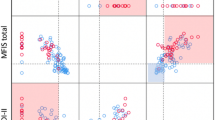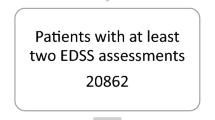Abstract
Multiple sclerosis (MS) is a chronic demyelinating disease of the central nervous system with variable types of disability progression (DP). Previous studies, defining different disability milestones (DMs), have reported symptoms at MS onset to be the predictors of DP and sex as a risk factor. Meanwhile, accounting for sex differences in MS, predictors in female and male patients might differ. To investigate whether the symptoms at MS onset predict reaching DMs in patients with relapsing–remitting (RR) MS and whether the predictors vary between different DMs and female and male patients. Data from 128 RR MS patients (84 females, 44 males) was retrospectively studied. EDSS scores 4 and 6 (associated with impaired ambulation) were taken as DMs. Association between symptoms at MS onset and time to reach DMs was assessed with Cox multiple regression model. Pyramidal symptoms and fatigue at MS onset predicted the progression to EDSS 4 in the whole study population (HR 1.84, 95% CI 1.07–3.2, p = 0.028 and HR 2.01, 95% CI 1.12–3.4, p = 0.011, correspondingly). The same symptoms predicted reaching DM in female, but not male patients. Bowel/bladder symptoms predicted reaching EDSS 6 in the whole study population (HR 4.31, 95% CI 1.47–12.6, p = 0.008) and female patients only (HR 3.93, 95% CI 1.04–14.8, p = 0.043). In female patients, fatigue was also the predictor of reaching EDSS 6 (HR 3.54, 95% CI 1.16–10.8, p = 0.026). Impairment of functional symptoms at MS onset can predict reaching DMs in patients with RR-MS, but the predictors for EDSS 4 and EDSS 6 differ in female and male patients.
Similar content being viewed by others
Data availability
The data used for this study are available from the corresponding author upon reasonable request.
References
Thompson AJ, Baranzini SE, Geurts J, Hemmer B, Ciccarelli O (2018) Multiple sclerosis. Lancet 391:1622–1636. https://doi.org/10.1016/S0140-6736(18)30481-1
Goodin DS (2014) The epidemiology of multiple sclerosis: insights to disease pathogenesis. Handb Clin Neurol 122:231–266. https://doi.org/10.1016/B978-0-444-52001-2.00010-8
Ramagopalan SV, Sadovnick AD (2011) Epidemiology of multiple sclerosis. Neurol Clin 29:207–217. https://doi.org/10.1016/j.ncl.2010.12.010
Thompson AJ, Banwell BL, Barkhof F, Carroll WM, Coetzee T, Comi G, Correale J, Fazekas F, Filippi M, Freedman MS, Fujihara K, Galetta SL, Hartung HP, Kappos L, Lublin FD, Marrie RA, Miller AE, Miller DH, Montalban X, Mowry EM, Sorensen PS, Tintoré M, Traboulsee AL, Trojano M, Uitdehaag BMJ, Vukusic S, Waubant E, Weinshenker BG, Reingold SC, Cohen JA (2018) Diagnosis of multiple sclerosis: 2017 revisions of the McDonald criteria. Lancet Neurol 17:162–173. https://doi.org/10.1016/S1474-4422(17)30470-2
Compston A (2006) Making progress on the natural history of multiple sclerosis. Brain 129:561–563
Jokubaitis VG, Spelman T, Kalincik T, Lorscheider J, Havrdova E, Horakova D, Duquette P, Girard M, Prat A, Izquierdo G, Grammond P, Van Pesch V, Pucci E, Grand’Maison F, Hupperts R, Granella F, Sola P, Bergamaschi R, Iuliano G, Spitaleri D, Boz C, Hodgkinson S, Olascoaga J, Verheul F, McCombe P, Petersen T, Rozsa C, Lechner-Scott J, Saladino ML, Farina D, Iaffaldano P, Paolicelli D, Butzkueven H, Lugaresi A, Trojano M, MSBase Study Group (2016) Predictors of long-term disability accrual in relapse-onset multiple sclerosis. Ann Neurol 80:89–100. https://doi.org/10.1002/ana.24682
Uher T, Vaneckova M, Sobisek L, Tyblova M, Seidl Z, Krasensky J, Ramasamy D, Zivadinov R, Havrdova E, Kalincik T, Horakova D (2017) Combining clinical and magnetic resonance imaging markers enhances prediction of 12-year disability in multiple sclerosis. Mult Scler 23:51–61. https://doi.org/10.1177/1352458516642314
Tortorella P, Laganà MM, Saresella M, Tavazzi E, Preti MG, Ricci C, Baglio F, Marventano I, Piancone F, Baselli G, Cecconi P, Caputo D, Clerici M, Rovaris M (2014) Determinants of disability in multiple sclerosis: an immunological and MRI study. Biomed Res Int 2014:875768. https://doi.org/10.1155/2014/875768
Gajofatto A, Calabrese M, Benedetti MD, Monaco S (2013) Clinical, MRI, and CSF markers of disability progression in multiple sclerosis. Dis Markers 35:687–699. https://doi.org/10.1155/2013/484959
Tedeholm H, Skoog B, Lisovskaja V, Runmarker B, Nerman O, Andersen O (2015) The outcome spectrum of multiple sclerosis: disability, mortality, and a cluster of predictors from onset. J Neurol 262:1148–1163. https://doi.org/10.1007/s00415-015-7674-y
Russo M, Crupi D, Naro A, Avanzino L, Buccafusca M, Dattola V, Terranova C, Sottile F, Rizzo V, Ghilardi MF, Girlanda P, Bove M, Quartarone A (2015) Fatigue in patients with multiple sclerosis: from movement preparation to motor execution. J Neurol Sci 351:52–57. https://doi.org/10.1016/j.jns.2015.02.031
Ramsaransing G, Maurits N, Zwanikken C, De Keyser J (2001) Early prediction of a benign course of multiple sclerosis on clinical grounds: a systematic review. Mult Scler 7:345–347. https://doi.org/10.1177/135245850100700512
Stewart T, Spelman T, Havrdova E, Horakova D, Trojano M, Izquierdo G, Duquette P, Girard M, Prat A, Lugaresi A, Grand’Maison F, Grammond P, Sola P, Shaygannejad V, Hupperts R, Alroughani R, Oreja-Guevara C, Pucci E, Boz C, Lechner-Scott J, Bergamaschi R, Van Pesch V, Iuliano G, Ramo C, Taylor B, Slee M, Spitaleri D, Granella F, Verheul F, McCombe P, Hodgkinson S, Amato MP, Vucic S, Gray O, Cristiano E, Barnett M, Sanchez Menoyo JL, van Munster E, Saladino ML, Olascoaga J, Prevost J, Deri N, Shaw C, Singhal B, Moore F, Rozsa C, Shuey N, Skibina O, Kister I, Petkovska-Boskova T, Ampapa R, Kermode A, Butzkueven H, Jokubaitis V, Kalincik T, MSBase Study Group (2017) Contribution of different relapse phenotypes to disability in multiple sclerosis. Mult Scler 23:266–276. https://doi.org/10.1177/1352458516643392
Kalron A, Givon U (2016) Gait characteristics according to pyramidal, sensory and cerebellar EDSS subcategories in people with multiple sclerosis. J Neurol 263:1796–1801. https://doi.org/10.1007/s00415-016-8200-6
Muccilli A, Seyman E, Oh J (2018) Spinal cord MRI in multiple sclerosis. Neurol Clin 36:35–57. https://doi.org/10.1016/j.ncl.2017.08.009
Dunn SE, Gunde E, Lee H (2015) Sex-based differences in multiple sclerosis (MS): part II: rising incidence of multiple sclerosis in women and the vulnerability of men to progression of this disease. Curr Top Behav Neurosci 26:57–86. https://doi.org/10.1007/7854_2015_370
Tintore M, Rovira À, Río J, Otero-Romero S, Arrambide G, Tur C, Comabella M, Nos C, Arévalo MJ, Negrotto L, Galán I, Vidal-Jordana A, Castilló J, Palavra F, Simon E, Mitjana R, Auger C, Sastre-Garriga J, Montalban X (2015) Defining high, medium and low impact prognostic factors for developing multiple sclerosis. Brain 138:1863–1874. https://doi.org/10.1093/brain/awv105
Damasceno A, Von Glehn F, Brandão CO, Damasceno BP, Cendes F (2013) Prognostic indicators for long-term disability in multiple sclerosis patients. J Neurol Sci 324:29–33. https://doi.org/10.1016/j.jns.2012.09.020
Rojas JI, Sánchez F, Patrucco L, Miguez J, Funes J, Cristiano E (2016) Structural sex differences at disease onset in multiple sclerosis patients. Neuroradiol J 29:368–371. https://doi.org/10.1177/1971400916666560
Kister I, Bacon TE, Chamot E, Salter AR, Cutter GR, Kalina JT, Herbert J (2013) Natural history of multiple sclerosis symptoms. Int J MS Care 15:146–158. https://doi.org/10.7224/1537-2073.2012-053
Patejdl R, Penner IK, Noack TK, Zettl UK (2016) Multiple sclerosis and fatigue: a review on the contribution of inflammation and immune-mediated neurodegeneration. Autoimmun Rev 15:210–220. https://doi.org/10.1016/j.autrev.2015.11.005
van den Vuurst de Vries RM, van den Dorpel JJ, Mescheriakova JY, Runia TF, Jafari N, Siepman TA, Rizopoulos D, Steyerberg EW, Hintzen RQ (2018) Fatigue after a first attack of suspected multiple sclerosis. Mult Scler 24:974–981. https://doi.org/10.1177/1352458517709348
Vaughn CB, Kavak KS, Dwyer MG, Bushra A, Nadeem M, Cookfair DL, Ramanathan M, Benedict RH, Zivadinov R, Goodman A, Krupp L, Motl RW, Weinstock-Guttman B, New York State Multiple Sclerosis Consortium (2018) Fatigue at enrollment predicts EDSS worsening in the New York State Multiple Sclerosis Consortium. Mult Scler. https://doi.org/10.1177/1352458518816619
Šabanagić-Hajrić S, Suljić E, Kučukalić A (2015) Fatigue during multiple sclerosis relapse and its relationship to depression and neurological disability. Psychiatr Danub 27:406–412
Funding
There was no external source of funding.
Author information
Authors and Affiliations
Contributions
Conceptualization: AI, YS, AS; Methodology: AI, YS; Formal analysis and investigation: AI, TM; Writing—original draft preparation: AI; Writing—review and editing: YS, TM, AS; Supervision: YS, AS.
Corresponding author
Ethics declarations
Ethics approval
Ethical approval was waived by the local Ethics Committee in view of the retrospective nature of the study and all the procedures being performed were part of the routine care.
Consent for publication
Not applicable.
Conflicts of interest
The authors declare that they have no conflict of interest.
Additional information
Publisher's Note
Springer Nature remains neutral with regard to jurisdictional claims in published maps and institutional affiliations.
Rights and permissions
About this article
Cite this article
Ivaniuk, A., Solodovnikova, Y., Marusich, T. et al. The impairment of the functional system and fatigue at the onset of the disease predict reaching disability milestones in relapsing–remitting multiple sclerosis differently in female and male patients. Acta Neurol Belg 121, 1699–1706 (2021). https://doi.org/10.1007/s13760-020-01478-0
Received:
Accepted:
Published:
Issue Date:
DOI: https://doi.org/10.1007/s13760-020-01478-0




